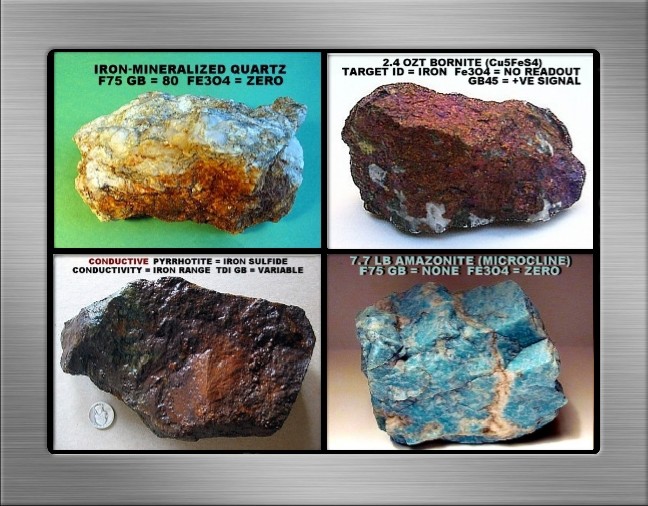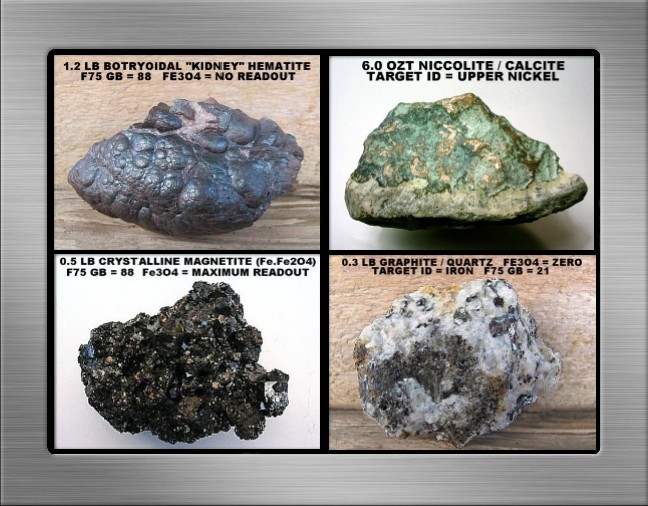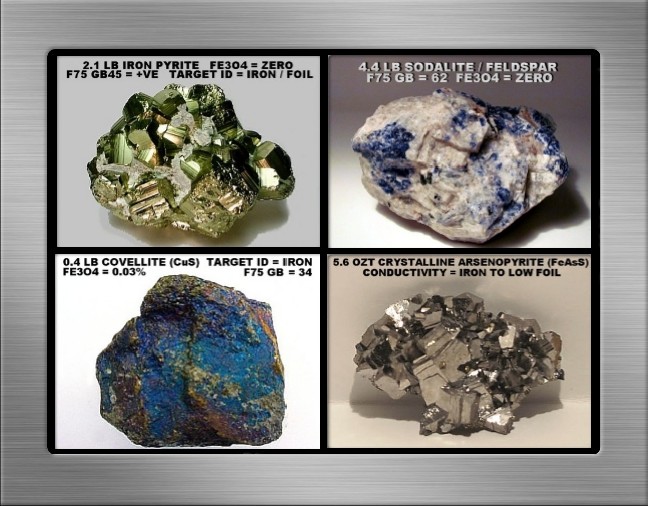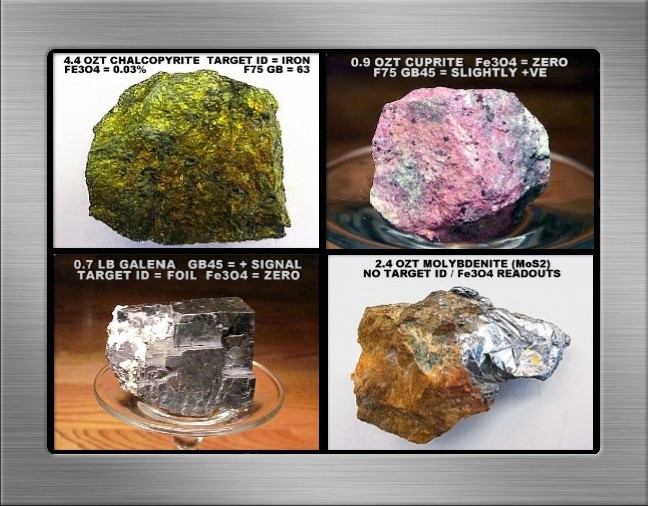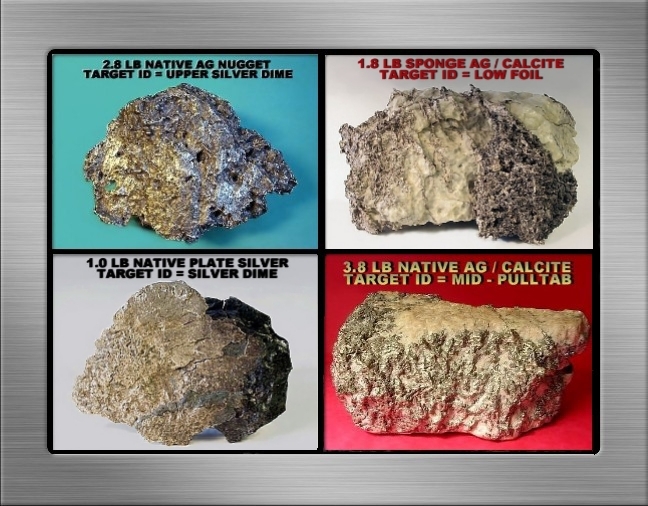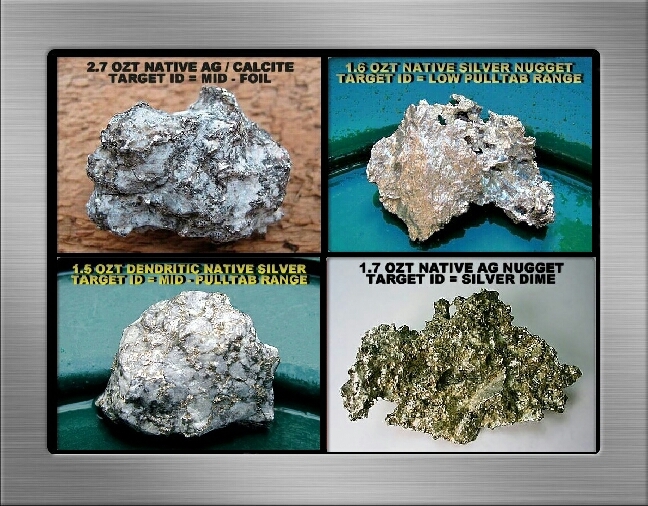-
Posts
251 -
Joined
-
Last visited
-
Days Won
1
Content Type
Forums
Detector Prospector Home
Detector Database
Downloads
Everything posted by Jim Hemmingway
-
Hi Simon… sorry to hear about your neighbor’s workshed. it’s too bad you don’t have their email address or phone # to advise them. They may have expensive equipment that might be exposed if the roof has been breached. Hope everything works out OK. The rock and mineral book you posted above will probably serve you well, and you will obviously need a local field guide. The Petersen Rock & Mineral guides are easy to read and understand. The advanced guide is a great reference, whereas the simplified version profusely illustrates the basics about rock and mineral formation, crystal forms, simple field ID tests, the individual mineral descriptions presented by category, followed by an index. You may find that the wealth of minerals described is a bit overwhelming at first, but before you know it, they will be as familiar to you as trusted old friends. You might eventually get yourself a little field portable spectroscope to assist with identification on the more transparent samples. I stand to be corrected, but I think it could also be useful to distinguish between fake and real stones in jewelry. This unit is about the length and twice the width of your little finger. I don’t have one yet but it looks like a handy little gadget once you learn how to use it. Simon, why don’t you message me your shipping address? I’m thinking about visiting the bookstore. If they have it, I could buy the simplified version and ship it to you ASAP. I don’t mind in the least, it’s only a few dollars, and besides I wouldn’t mind poking around their geology section to see what else is available. I’ve included two small sample photos of silver above as a result of your comment in your most recent post, so thankyou. We have many fluorite collecting sites in central or eastern Ontario but I have little interest in pursuing it. I think I traded silver for the fluorite sample below. I’m not sure because there have been so many requests over the years that it’s all a muddle now. The time came when my small silver supplies were nearly depleted, and I had to discontinue that practice............................. Jim.
-
Hi Simon… thanks for popping in!!! I do think that mineralogy in concert with metal detectors is a fascinating pursuit that without question could keep me occupied for an eternity. My interests incline to the natural sciences, but metal detection was introduced to me by mere happenstance. It is surprising how frequently we see that such trivial chance or unlikely probability determines lifelong interests don’t you think? You have several metal detectors well suited to rock and mineral benchtesting. I’m not familiar with your other units, but your T2 and GB Pro should suffice nicely. I fully agree with you that the arsenopyrite is unusually handsome, but then I’m a fool about minerals. Benchtesting is technically quite simple, whereas drawing the right conclusions may require access to information about local rocks and minerals. It might be a good idea to acquire a few understandable mineralogy texts. The Petersen Field Guides are excellent references, both the detailed and the simplified versions authored by Frederick H. Pough. I always keep the more compact simplified version handy in an outer knapsack pocket when in the field. A good portion of what we hobbyists learn is self-taught from direct hands-on field experience, hence I can’t overemphasize the importance of understandable field guides. If you’d prospected here in northeastern Ontario, you’d be familiar with the mineral pyrolusite (MnO2). It’s a general term used to describe a secondary manganese oxide that coats / blackens the surface of manganese-bearing rocks in the tailing piles, shorelines or other surfaces exposed to natural (oxidation) weathering. As a point of interest, we have manganese in a reduced ionic state (Mn+1) in our groundwater supplies. It can create laundry-staining issues when it oxidizes (loss of electrons) from Mn+1 to Mn+2. This results when exposed to strong bleaching agents (for example chlorine) because manganese oxidation stains laundry water black. I have an excellent example of pyrolusite but won’t bother with a photo because it is so doggone non-descript and unattractive. I’ve been remiss by not including a silver photo in the article, so below is a small plate silver which is labeled as a “nugget”. Hi Steve… thanks for stopping around!!! Your comment is most kind, and coming from you it constitutes a very nice compliment indeed. Thankyou for that and for all else that you do on the forum to our benefit. As to the above article, I wanted to contribute something interesting to the forum. It’s a curious psychological reckoning insofar as you can only read what others contribute for so long, and not experience the need to contribute something in return. There were quite a number of minerals whose photos could have been attached to the above article. That was impractical, so depicted below is specular hematite. I don’t know if you encounter this material in the southwest. We have some high production iron mines in several localities, including the renowned surface extraction facility at Marmora, Ontario. Unlike other types of hematite (that I know about) this material, although not exhibiting nearly the full magnetic susceptible strength of magnetite, does seriously react to VLF metal detectors. Hi Bob… thanks for dropping by… your comment is too kind. This article directly resulted from our discussions in recent months about mineral identification. Those exchanges prompted me to conscientiously examine some of my samples, many of them lost forever in dusty boxes in the basement. One thing led to another, the keyboard started clattering away one day, and the final result looked appropriate for Steve’s Rock and Mineral sub-forum. I don’t recollect where the sample below came from, although it’s undoubtedly from an abandoned site in the Temagami copper district just south of northeastern Ontario’s silver country. I haven’t searched there in some 30+ years.
-
Benchtesting Rocks & Minerals with an F75 Metal Detector Introduction From the earliest time when we were aware of our surroundings, most of us looked for pretty rocks. We wondered what interesting or valuable minerals might possibly comprise them. Now as adult hobbyists, I doubt if any of us hasn’t benchtested an interesting rock from curiosity, and wondered what actually produced the signal. Although a sensitive benchtest usually has little in common with how marginally conductive rocks and minerals respond to metal detectors in the field due to ground effects, we can learn and become familiar with how rocks and minerals in our respective areas respond to metal detectors in a benchtest. A sensitive metal detector’s electromagnetic field penetrates rocks, usually generating either a positive or a negative signal in response to whatever material is in the rock. We can sometimes determine whether such signals should be investigated further, or whether worthless iron minerals produced them. I’d generally describe my benchtest results as worthwhile and informative, but that notwithstanding, I look forward to doing a benchtest because I think it is an intriguing study on its own merit. That said, how do you conduct a benchtest? I’ll describe my methods and hopefully we’ll see what you think about it. Benchtest Requirements and Techniques Benchtesting ideally requires a visually displayed, fully calibrated, manually adjustable ground balance that covers the entire (soil) mineral range from salt to ferrite. As a minimum, the detector should feature a threshold-based true motion all-metal mode, and preferably an additional true non-motion all-metal mode for significantly improved sensitivity to borderline samples. Visual displays in either of the true all-metal modes are essential for target ID, Fe3O4 magnetic susceptibility and GB readouts. I prefer a small (concentric) coil to promote detector stability and improve sensitivity to the rock sample, to ensure uniform sample exposure to the coil, and to minimize EMI (electromagnetic interference) especially if benchtesting at home. Elevate the sensitivity control as high as possible while maintaining reasonable detector stability such that you can clearly hear changes to the threshold. To check for a target ID, move the sample back and forth across the coil at a distance that produces the best signal but does not overload the coil. To determine ground balance and Fe3O4 readouts, advance the sample toward the coil, back and forth to within an inch or two (depending on sample size and signal strength) of the coil’s electrical sweetspot. Ensure your hand does not come within detection range of the coil to avoid creating false signals. If you extend your fingers to hold the sample, this is not an issue when testing larger samples. If necessary use a plastic or wood food holder that can firmly grasp small samples. Benchtests should be conducted utilizing a minimum of two widely diverse GB control adjustments. Initially I prefer the same GB control adjustment that is typically required to keep my detector ground-balanced to the substrates in my prospecting areas. It’s a personal preference that works for me. That particular GB control point (F75 / GB86) is more likely to improve any rock or mineral sample’s signal strength compared to using a more reduced (more conductive) GB compensation point. The next step is to use a dramatically reduced GB control adjustment (F75 / GB45) as suggested by Fisher Research Engineering. This setting ensures that (obviously weathered) oxidized samples do not generate a positive signal from any type of non-conductive iron mineral inclusions, particularly maghemite mineralization that may be present within such rocks. It follows that this second benchtest will, if anything, slightly subtract from the sample signal strength, particularly with low grade and otherwise marginally conductive samples, compared to the first step of the benchtest at GB86. As a general rule, I do not recommend the F75 / GB45 compensation point for benchtesting (non-oxidized) mafic samples that are dominated by constituents such as common magnetite or other black minerals that normally support highly (non-conductive) elevated GB readouts. Such samples can produce strong negative threshold responses at the reduced GB compensation point. It will be difficult or impossible for the signal from a marginally conductive substance to successfully compete with those negative threshold signals. For non-oxidized samples Fisher Research Engineering suggests using F75 / GB65 rather than the F75 / GB45 compensation point, since obvious iron mineral oxidation should visually be absent from such samples. With the above discussion in mind, extremely fine-grained, unweathered magnetite that occurs in pyroclastic material (for example volcanic ash) can drop into the GB45 range, but it is extremely rare. Unweathered volcanics do frequently drop into the GB70's due to submicron magnetite, but the recommended F75 / GB65 compensation point will eliminate those positive signals. The arsenopyrite sample depicted above is a good example of a commonplace mineral that we encounter in the silverfields of northeastern Ontario. Generally field examples could be described as marginally conductive and many are low-grade. A good many react with only a mild positive signal, and sometimes not at all to a benchtest depending on which GB compensation point is used. The high-grade, solidly structured sample above produces a strong positive signal in either zero discrimination or true motion all-metal mode with the ground balance control adjusted to the GB compensation point required for our moderately high mineralized soils. As noted, that’s approximately F75 / GB86, although in the field, of course, it varies somewhat depending on location and coil type / size employed. The response is not as strong as a similar size and shape metalliferous sample would produce, but it does generate a surprisingly strong benchtest signal that would be readily detectable in the field. Even with the GB control dramatically reduced to more conductive values (F75 / GB45), to ensure that any positive signals produced by non-conductive iron mineral inclusions should now only produce a negative threshold signal, it is no surprise that this (non-oxidized) specimen continues to generate a strong signal. For those readers unfamiliar with detector responses to such minerals, the same general response scenario described above with arsenopyrite applies to other marginally conductive minerals such as galena, pyrrhotite and to a lesser extent even iron pyrites. Ordinary iron pyrites is generally innocuous, but maghemitized pyrite, pyrrhotite, and the copper sulfide ores, particularly bornite and chalcocite, can be a real nuisance in the field due to magnetic susceptibility, magnetic viscosity, and / or electrical conductivity, just depending on what minerals are involved. Such variable responses from arsenopyrite and many other mineral and metalliferous examples clearly infer that signal strength and potential target ID depends on a sample’s physical and chemical characteristics, including the quantity of material within a given rock. These factors include structure, size, shape, purity (overall grade), and magnetic susceptible strength of iron mineral inclusions. Moreover, the VLF detector’s sensitivity, the GB compensation points employed, the coil type and size, and the sample profile presented to the coil further influence benchtest target signal strength and / or potential target ID readouts. Incidentally, neither of my PI units will respond to the arsenopyrite sample depicted above, even with a TDI Pro equipped with a small round 5” mono coil, the GB control turned off, and a 10 usec pulse delay to deliver its most sensitive detection capability. That result is typical of most, but certainly not all sulfides and arsenides that occur in my areas. Higher grade and solidly structured pyrrhotite, an unwelcome nuisance iron sulfide, and collectible niccolite, a nickel arsenide, are commonplace mineral occurrences here that do respond strongly to PI units, although their respective VLF target ID ranges are quite different. As a related but slight diversion, the photo below depicts a handsome example of the widely occurring mineral sphalerite. It forms in both sedimentary beds, and in low temperature ore veins. It is interesting to collectors because it possesses a dodecahedral cleavage which means that it breaks smoothly in twelve directions, and it is usually triboluminescent, meaning that it gives off a flash of light when struck sharply. Like many desirable minerals lurking in prospecting country, unfortunately sphalerite doesn’t react to metal detectors. A Final Word The foregoing is intended to illustrate that sensitive metal detectors can be utilized as a supplementary tool to assist with evaluating rocks and minerals. There is no question that the benchtest has serious limitations, particularly if trying to distinguish positive signals produced by some types of iron mineral inclusions from weak conductive signals. That notwithstanding, a positive signal that persists below the F75 / GB45 compensation point cannot be confused with iron mineral negative threshold signals produced at that same compensation point. Therefore a positive signal merits further investigation. Such signals are almost certain to be generated by a marginally conductive mineral or a metalliferous substance. On the more interpretive side of a benchtest, we need to point out that weak positive signals from lower-grade samples of minerals such as arsenopyrite, galena, pyrrhotite, chalcopyrite, and doubtless a few others, may disappear well before the GB control is reduced to the F75 / GB45 compensation point. We learn early that benchtests are frequently equivocal and require interpretation based on any further evidence that might support the benchtest result. Look for iron oxidation in addition to structural or other physical evidence as described above that could explain why a sample reacts as it does to a metal detector. Jim.
-
Hi 1515Art... I don't know what it is and I won't make a wild guess either. However, thankyou for posting these extraordinarily clear, well-exposed and framed specimen photos. It is a beautiful sample, hopefully someone here will be able to make an ID for you. Jim.
-
Help Identifying A Rock
Jim Hemmingway replied to brad4555665's topic in Rocks, Minerals, Gems & Geology
Oh I quite agree Jeff. Brad’s photos could depict a number of common sulfides / arsenides and there are other possibilities. For example, I have a few ore samples exhibiting native silver ‘horns’ and veinlets protruding from oxidized surface niccolite embedded in a light brown carbonate rock, that look very similar to Brad’s sample. But I seriously doubt this is what Brad has found in his area, as these are quite rare. We make our best guess based on the info provided and what we think we see in the photo. The one photo appears to depict some foliation, but there’s no way to be certain. This is why I included a schist photo for him to do a comparison. It ensures that he’ll know if his sample is schist or something else. Jim. -
Help Identifying A Rock
Jim Hemmingway replied to brad4555665's topic in Rocks, Minerals, Gems & Geology
Hi Brad… your photos are a bit blurred, but your sample appears to be a “schist”. Schist is a generic term for a foliated metamorphic rock. It displays well-developed foliation (leaves or sheaves of leaves), often through inclusion of mica. It represents the ultimate stage of metamorphism. A schist is usually derived from fine-grained sedimentary rock such as shale that has been exposed to some combination of heat / pressure. Individual minerals in schist have grown during metamorphism so that they are easily visible to the naked eye. Foliation takes place when pressure squeezes the flat or elongate minerals within a rock so they become aligned. These rocks develop a platy or sheet-like structure that reflects the direction that pressure was applied. Schists are named for their mineral constituents, for example, mica schist is notably rich in mica such as biotite or muscovite. From what I can see, that is what is depicted in your photo. Below I’ve included a close-up depiction of a mica schist so that you can compare your sample to it as a confirmation. Hope this helps. Jim. -
Hi Strick… that’s a good assortment of finds with your Equinox 800, particularly what may be an antique gold ring, powder flask, and Chinese coin. You might not have done so well at the beach as things stand, which just goes to show that sometimes it pays to follow your instincts or inclination. The Chinese coin is an unusual find over here in central Ontario, but we do infrequently find them in older parks and schoolyards, and former picnic groves. They tend to be in fairly good condition compared to older copper coin finds, but that is probably due to a different alloy composition and / or soil chemistry here. Thanks for sharing your outing and those just excellent photos with us!!! WTG Jim.
-
Hi Ammie… well you didn’t find a plate or button, but still... you did find some nice relics, even I can recognize those three-ringers, definitely keepers. The copper percussion cap is a real nice find too. Can’t help you with identification, hopefully someone else will do so. I think your readers will agree that we admire your enthusiasm and willingness to get into the field and give it the old college try. I think you've done very well. Thanks for the excellent photos, and for this latest update to your detecting adventures. WTG Jim.
-
Nice haul Terry!!! Just love those Wheaties, Indian Heads and Mercury dimes. You know the old saying: “when wheaties are here, silver is near”. I’ve hunted in some bad “neighborhood” parks deep in lower Toronto where violent and destructive behavior, robberies, drugs, and prostitution rule. I finally had to give it up despite that one park was the best producer I’d ever found… full of old silver, old large British / Canadian cents, and plenty of other goodies, especially men’s silver rings which was odd. Good signals everywhere, a detectorist's paradise. It was just not worth risking assault or worse. There were a few close calls with trouble-hunting individuals looking for a perceived easy mark. On a more positive note, the truly dangerous ruling gang members (who I repeatedly went out of my way to explain exactly what I was doing) seemed kindly disposed to leave me alone. In fact, when they were in near proximity, absolutely nobody approached or otherwise bothered me. However it was open season on police cruisers and taxicabs, throwing rocks at these vehicles apparently was their favorite pastime. Glad you came out with a whole skin Terry, maybe you’re better off prospecting gold nuggets in Arizona where you only have to deal with tarantulas, poisonous snakes, cougars, and so forth. Easy pickings compared to Yonkers. Jim.
-
Hi Ammie… demolition sites are a tough proposition for the reasons you described, the elevated trash levels masking good targets and no doubt some desirable targets were buried beyond detection depth. Moreover, the soil movement (disturbed soil conditions), plays havoc with target ID on coins deeper than roughly four inches depth in our soils, and we keep that in mind when detecting urban renewal projects. Searching in such difficult conditions, those wheaties could just as easily have been silver and obviously had to be dug. The Whiskey Good Luck token is an unusual and interesting find, a keeper. For a first time visit, I think you did as well as could be reasonably expected, especially considering your limited time on site. As you continue traveling to new areas, if at all possible (and I realize that it is easier said than done when you’re on the road) keep an eye out for old schools and ballparks, and especially the old picnic groves. (Any sign indicating “something Grove” is liable to be a picnic grove of long standing with the local community). These are great places to find older silver coins, tokens, and occasional jewelry items without having to deal with excessive junk. Incidentally, I don’t know for sure, but that the CSA belt buckle you posted above would probably read somewhere in the copper penny / silver target ID range. When relic hunting that three-acre property adjacent to the civil war site, it is also possible that a very deeply buried buckle might produce a questionable target ID signal. Target ID will depend on just how deep it is, the soil moisture and mineralization present, and the buckle profile presented to the coil… something to keep in mind when detecting deeper, but reasonably well defined target signals that are indicative of non-ferrous targets despite a possible iron target ID. Thanks for keeping us updated Ammie, and again for those illustrative photos, it’s been fun reading about your travel / detecting adventures. Good luck if you get to detect that civil war site tomorrow!!! Jim.
-
Weekend Finds With Gm1000.....
Jim Hemmingway replied to oneguy's topic in Detector Prospector Forum
Congratulations oneguy… those “little guys” look awfully good to me!!! Moreover, you spent the weekend outdoors enjoying the hobby and obviously having success with your Gold Monster. It doesn’t get any better than that IMO. WTG Jim. -
WOW Lunk!!!! Holy Cow, I'm impressed with what you've accomplished!!! WTG!!!! Jim.
-
A Couple Of Paperweights That Live On My Desk
Jim Hemmingway replied to phoenix's topic in Detector Prospector Forum
Phoenix... I really like the looks of mineralized quartz, it has a singular beauty all its own. The gold is sauce for the goose. Attractive finds both, congratulations on two very unique bookends!!! Thankyou for sharing this photo with us. Jim. -
Hi Ammie… it’s too bad those Lake Lanier beaches proved to be barren of any valuables, but I have a feeling that your fortunes are about to change. Searching a property adjacent to Civil War battleground should yield some interesting finds. I sure hope you’ll find at least a few valuable artifacts, and I think the law of averages ought to work in your favor this time around. I can’t advise you about settings for the Equinox, other than perhaps to adjust it to eliminate small nails and other small non-descript iron. And only then because your time there is quite limited, so in all likelihood you’ll have to focus on the more promising signals. Now if time permits, I’d search in the motion all-metal mode (if there is such a mode, and I think a forum friend mentioned there is) for maximum depth and refer to the target ID to decide what to dig. Just keep in mind that deeper non-ferrous targets might also read as iron, so I would suggest you dig those deep targets regardless of target ID. A disclaimer is appropriate here because I’m not a knowledgeable relic hunter, most of my experience lies elsewhere. But it is an interesting question because there are doubtless valuable or desirable civil war relics comprised solely of iron / steel. I really do think that your limited time on site has to take precedence in deciding what types of signals to dig. Hopefully, someone with relic hunting experience will step into this discussion and offer you more knowledgeable suggestions. Thankyou for sharing your most recent activities with us, and also for those wonderful photos. Good luck with everything Ammie, and please do keep us posted. Jim.
-
Hi Idahogold…. I’ve been hunting silver for 30+ years in northeastern Ontario, and have written many articles about it, occasionally profiling the utility of different VLF and PI models in those environs. Some of these were posted to Steve’s former AMDS forum, and more recently to the TreasureNet forum. Here’s a link to an example entitled Electronic Prospecting in Silver Country if you wish to view it. http://www.treasurenet.com/forums/canada/282315-electronic-prospecting-silver-country.html I’ve had a lot of unusual and enjoyable experiences, and sometimes managed to find good silver. It’s the entire package that interests me, hiking and exploring, photography, observing wildlife, campfire cookouts, and sleeping well outdoors. It’s been a privileged and altogether wonderful life through the pursuit of this hobby. In retrospect, I wouldn’t change anything even were it possible to do so. For the present at least, my interest has turned to searching for non-detectable minerals such as the example depicted immediately below. In keeping with your comments, I’ve also added a multi-photo of silver. Thanks for the nice reply, and hopefully we’ll have the chance to shoot the breeze again here. Incidentally, I quite enjoyed your post about the apparently not-so-elusive Sasquatch!!! It was an entertaining tale. Happy Trails. Jim.
-
Hi Ammie… thankyou for another fine installment to this thread. I do envy your freedom to travel to new places and detect those lovely beaches, especially where it is reasonably warm and sunny. We are still experiencing winter conditions, highly unusual for April in central Ontario. I agree with you that it may have been an unfortunate mistake to ask for permission to metal detect in the parks. While I realize that this may not apply in your case, I was once told the same thing by a municipal employee despite that there are no bylaws or regulations banning the use of metal detectors in the local parks. Years ago I was detecting the beach shallows in Arrowhead Provincial Park, Ontario. The park manager informed me that metal detecting was not allowed because they didn’t want arrowhead artifacts disturbed. As a biologist and former MNR employee, I explained to him that the park was named for the prolific growth of an edible water plant named Arrowhead, and not for native arrowhead artifacts. That discussion was followed by a more relaxed conversation about mutual acquaintances within the MNR, our experiences, and so forth. As I was leaving to meet the wife and kids, he said that it would be OK to detect the beach. Incidentally, at least at that time, there was nothing posted to prohibit the use of metal detectors in that park. Nowadays Ammie, I don’t ask for permission. I do check provincial and municipal websites regarding any rules or regulations prohibiting metal detecting. If there is nothing listed there or posted at the park itself, I presume there is no issue with metal detecting. Of course historical sites, private property and so forth are strictly off-limits. Looking forward to your next installment to this thread, meanwhile good luck with your continuing detecting adventures. Jim.
-
Idahogold… thankyou for sharing your experience with us. I can’t say which was more fascinating, the bacon and eggs for breakfast or finding elusive gold… both looked awfully good to me!!! I enjoyed the video’s relaxed atmosphere, and fully appreciated that newcomers to the hobby will certainly benefit from watching your gold recovery technique. It’s still quite a revelation to see the tiny gold that can be detected by the SDC 2300. Congratulations on finding gold, and otherwise for an entertaining and instructive video. Jim.
-
Thankyou Ammie for posting this series of adventures. Please do continue to write about your travels and beach-hunting experiences. It's interesting exposure to areas that I'd otherwise never know about, and I enjoy your writing style. Jim.
-
Hi DDancer… no worries, there’s no way for most of us to know that a brown variety of quartz exists in Alaska. Although it is a bit dark, citrine was a very reasonable ID, and you did qualify your response. The technique about heating amethyst is widely known by collectors. Good eye on the tourmaline too, it wasn’t an ideal example. It is the (nearly) triangular cross-section or end view that very much helps to identify this mineral. Attached are two photos to illustrate this structural characteristic below. Thanks DDancer, you know your rocks and minerals pretty darn well. Jim.
-
Visiting With Jim Straight
Jim Hemmingway replied to Reno Chris's topic in Detector Prospector Forum
Thanks Chris for posting the above photo. Good to see that he is able to get about and attend the rock and mineral shows in that area. Jim’s prospecting articles and books, metal detector reviews, and his enthusiasm to engage with hobbyists has earned him respect and admiration throughout the prospecting and mining community. I made his acquaintance many years ago and we subsequently have corresponded down through the years, usually about detectors, and rocks and minerals. In recent times I’ve made an extra effort to describe to him our prospecting trips up here in northeastern Ontario, and provide lots of photos so that he can easily visualize our search environs, our diggings, and our silver recoveries. It’s no accident that so many hobbyists over the years have remarked on these forums that Jim Straight has sent them signed copies of his books. I have no doubt that a kindly letter frequently accompanies those books as well. I might add that my books were gifted to me, and I’m certain that he has been equally thoughtful and generous to many others in the hobby. That’s it for now… just wanted to add my two cents about a fine individual, a friend, a mentor, and in the annals of modern prospecting in the great southwest… he has been a Pathfinder. Jim. -
Overall Observations Of The Equinox
Jim Hemmingway replied to Wayfarer's topic in Metal Detector Advice & Comparisons
I agree with the above comments Wayfarer, I very much enjoyed reading your report. It is coherent and understandable, and you've addressed the questions that came to my mind. More importantly, I would imagine that even rank newcomers to the hobby would find it an informative pleasure to read. Thanks so much for this excellent effort to share your findings with us. Jim. -
Hi Hibby… I can’t speak to this topic from direct experience, but I did take a moment (while viewing the Pittsburgh Penguins hockey game) to look on the Internet for an answer to your question. I was curious to learn more too. According to The Fossil Forum, ammonite fluorescence will vary with the type of mineral replacement that has formed the fossil. That makes perfect sense, hence some ammonites will simply not fluoresce, some will fluoresce only under short wave UV light, and some only under longwave UV light. Of course it goes without saying that the light intensity makes a difference as to how well potentially fluorescent minerals respond to UV light. Hope that helps... Jim.
-
Hi Hibby... we'll ignore your second question because it has been suitably addressed above. Shortwave light is not the same thing as black light at all. Light below the wavelength of violet light is described as ultraviolet light. Keep in mind as you read this explanation that ultraviolet (UV) light is invisible to the human eye. Longwave UV peaks at about 360 nanometers, while shortwave UV peaks at about 254 nanometers. Midwave UV light is generally considered to peak at about 312 nanometers. "Blacklights" are an inexpensive way for beginners to get started in the hobby as they do produce longwave UV light that will work fine for minerals that happen to fluoresce brightly when exposed to such light. While equipped with a visible light filter, these inexpensive filters are not nearly as effective as the visible light filters incorporated into shortwave, midwave, and longwave UV lamps suitable for observing fluorescent minerals. Hence the visible light inherent to using blacklights can and does frequently overwhelm the longwave UV light effects on fluorescent minerals. Next basic thing to understand is that most minerals do not fluoresce brightly under longwave UV light. In order to see all the bright colors that make fluorescent minerals so attractive, as a minimum you will require a shortwave UV lamp. As a general rule of thumb, these are considerably more expensive than longwave UV lamps, and also should be used with protective eyewear. A good battery-powered shortwave UV field lamp is priced comparably with entry level VLF metal detectors. Midwave lamps are usually purchased only by advanced hobbyists, and are at least as expensive as shortwave UV lamps. There are a number of minerals that respond better to midwave UV light than to either shortwave or longwave UV light. Hope this helps to clarify things a bit… Jim.
-
Doc… you are comparing an ideally round shape in the form of a refined silver coin that readily supports induced eddy currents to naturally occurring nuggets that usually target ID as low conductors because for various reasons they are not ideal candidates to support induced eddy currents. Why is that the case?? How well a nugget will support eddy currents, and generate whatever signal strength and target ID will depend upon physical / chemical parameters such as size, shape, purity, types of mineral inclusions, structure (for example… dendritic, plate, disseminate or particulate, sponge, nuggety or massive), and the profile presented to the coil. Such factors are invariably less than ideal to support eddy currents, and hence testing nuggets of differing size, shape and structure will produce a variety of PI time constants. See the comparison photo of silver examples below, but keep in mind that a large portion of our silver ores and nuggets do target ID within the foil to nickel range. Small nuggets, similar in size to those in the photo, that target ID in the silver dime range are relatively quite rare. Ground conditions also play an important role determining in-situ target ID, and refer to factors such as the strength of non-conductive magnetic susceptible iron minerals, ground moisture content, proximity of adjacent targets, and disturbed ground. These factors occasionally contribute to perfectly good silver nuggets and ores at depth producing a VLF target ID in the iron range. Hope this post helps... Jim.
-
I Know This Is Off Topic But...
Jim Hemmingway replied to phoenix's topic in Detector Prospector Forum
Hi Dave... I agree with Fred, in fact I think your photo represents as nice a display of gold nuggets as I've seen here lately. That said, I hope 2018 will be your best year ever!!! Thanks for the photo and WTG!!! Jim.



